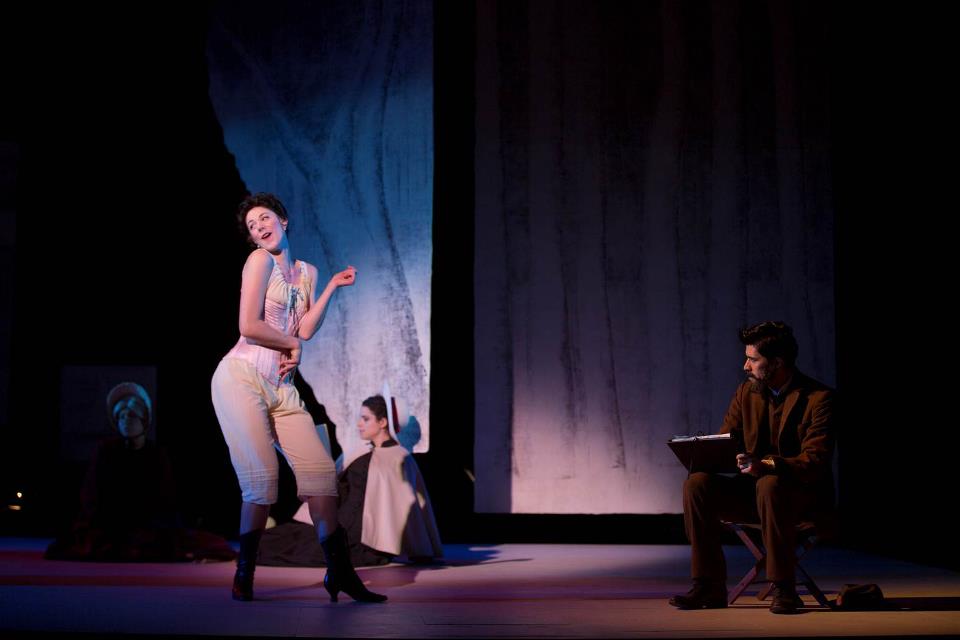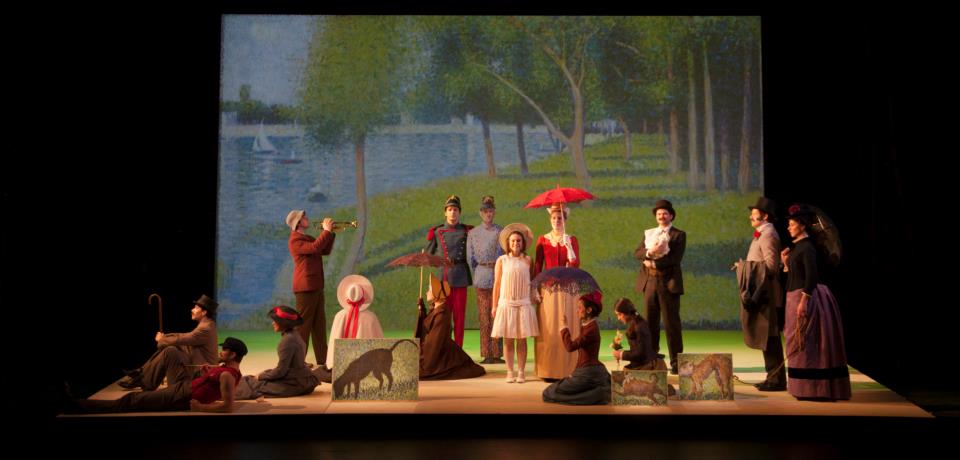The Visit, the first YSD thesis show of the year, directed by Cole Lewis, is a play by Friedrich Dürrenmatt dating from the 1950s. We might say it’s a play about “justice, greed, and the American way” but for the fact that the play is set in a German town called Güllen and, thus, was initially intended as a comment on the bad consciences of post-war Germans, where virtually any town had its distressing history of fascism and scapegoating. The YSD production doesn’t update the setting, much—which allows for fun with certain period aspects of German costuming—but makes the play abundantly relevant to our country and our times, where many townships that can’t boast major industry or global investment companies are falling into the dire penury we find among the good folks of Güllen. What will they do to pull themselves out of the economic quagmire? Why, find a patron, a donor, or maybe even an investor. The potential “good angel” is Claire Zachanassian, a native of Güllen who has been abroad for forty years—long enough to have had seven marriages and to have amassed a fortune of at least $3 billion. Her return has all the townsfolk a-tizzy as the play opens, including her girlhood flame Alfred Ill, who the city fathers hope can sweet-talk Claire into generosity. Despite a lyrical, two-on-a-swing interlude between the former lovebirds, we find out that something rather bad befell Claire thanks to Alfred, and that she’ll pay up to the town’s coffers only if she gets payback. She wants Alfred dead.
Of course, the mayor and all the townsfolk reject this proposal—even if Alfred did in fact do her wrong in the remote past, it’s not justice to put a billion dollar price on his head, making the town’s salvation dependent on his execution. And so, as many “good Germans” would immediately recognize, the horrible and hidden past can hold the present hostage. What’s more, one finds that one’s fellow citizens are apt to join together against whoever stands between them and prosperity. And that person—here only an individual (a shopkeeper) but elsewhere an entire race—can become a scapegoat for the will of the people.
That is the ingenious plot that Lewis’ cast enacts in this impressive ensemble affair. Few are the actors here who play only one role, and the movement and activity in the Iseman's varied playing space keeps this longish show lively. Most of the fun is in the early going, as things get increasingly sinister and appalling as the play goes on, and it does go on. Be prepared to be exhausted by the time it’s over.
The principals in the cast carry their roles with aplomb: as Claire, Mariko Nakasone is an extremely sexy sexagenarian, combining a steely sturdiness with feline graces—and she gets some great costumes too; she’s too odd to command our sympathies, though she does have grounds for claiming herself wronged. Chris Bannow’s Alfred seems more appropriately aged and we sense that, whatever his faults in the past, he has tried to overcome them in good bürgerlich fashion. His role grows in stature when we begin to sense, as he does, that the whole town is against him—a chilling moment when he tries to leave town plays like something out of the Twilight Zone. As the Mayor, Matthew McCollum is affable and unctuous and keeps us—we sometimes double as the citizens of Güllen, waving flags at appropriate moments—in the palm of his hand.
Among the rest of the cast, there are many fine moments as well, particularly Mamoudou Athie as the Schoolmaster, the one figure here who mounts an effective plea—on television, no less—against what is happening. It’s good to see Athie given a role not predominantly comic, though he does also get hit over the head with a painting. Other fun comes from Celeste Arias, as a moustache-sporting film star (two different versions) married to Claire, and as the frowsy wife of Alfred, and from Iris O’Neill, a child actress who gets to do things like pull a wagon across stage and vamp on a toy accordion, and pretty much steal her every scene.
Elsewhere, Ceci Fernandez and Mickey Theis cavort enthusiastically as roly poly eunuchs, creepy and unsettling—and they also lend great effect as the TV team who come to cover Alfred’s great “sacrifice.” In fact, dressing up Theis in a variety of outfits is almost endlessly entertaining—he plays three other roles, including a teenager. Montana Levi-Blanco’s costumes are inspired: the outfit for the Butler, besides making Elia Monte-Brown almost unrecognizable, seems a surreal, androgynous take-off on something out of Monopoly. And then there are the cast's tell-tale yellow shoes…
The scenic design by Chika Shimizu is wide open in the first half, with different spaces provided by small-scale buildings to represent the brick and mortar sturdiness of the town. Later, we get a shop, and a cardboard cut-out car that works quite effectively. There are also plenty of entrances, exits, use of the catwalk, and special effects. Kristen Ferguson’s collage projections in the slideshow segment are wonderful in evoking a hint of Georg Grösz by way of early Cubism. Brian Hickey’s sound design, I suspect, will yield new things on every viewing. I was keen enough the first night to pick up the sound of a gramophone stylus spinning in the endless groove at the end of a record as things began to close in on Alfred. Caitlin Smith Rapoport’s lighting design met the challenge of so much action in so many places, creating outdoors, indoors, and, in one great sequence when the Doctor (Merlin Huff, winningly and ineffectually conscience-stricken) attempts to appeal to Claire's good nature, raking autumnal light flowing through a fence over scattered leaves.
Cole Lewis aims her version of The Visit at the human ability to rationalize any barbarity or indulgence in the name of our capacity to please ourselves and avoid considering the consequences. If you don’t find yourself stabbed at some point in this production, then you just aren’t paying attention.
The Visit By Friedrich Dürrenmatt Translated by Maurice Valency Directed by Cole Lewis
Scenic Designer: Chika Shimzu; Costume Designer: Montana Levi Blanco; Lighting Designer: Caitlin Smith Rapoport; Sound Designer: Brian Hickey; Projection Designer: Kristen Ferguson; Production Dramaturg: Lauren Dubowski; Stage Manager: Emily DeNardo
Cast: Celeste Arias; Mamoudou Athie; Chris Bannow; Jabari Brisport; Cornelius Davidson; Ceci Fernandez; Christopher Geary; Merlin Huff; Sarah Krasnow; Matthew McCollum; Elia Monte-Brown; Mariko Nakasone; Iris O’Neill; Jennifer Schmidt; Mickey Theis
Yale School of Drama October 29-November 2, 2013

